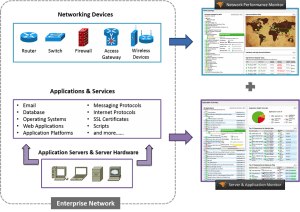Whenever there’s an application performance issue, it is not uncommon to start the blame game between network admins and system admins as to where the issue is. Network admin tend to say there’s an application issue and sys admins should resolve it while system admins ascribe it to a network issue and want the network admins to troubleshoot it.
An enterprise network is comprised of both networking (routers, switches, firewalls, etc.) and systems infrastructure (applications, servers and end-user systems) and both are equally important in maintaining IT health. In smaller organizations where there’s just a single IT admin managing the entire IT environment, it becomes all the more difficult as he/she has to isolate the cause of the downtime all by themselves, and then troubleshoot the issue.
Whether it’s the network or an application issue, it’s ultimately the business service which fails and it’s paramount to have a unified insight into the performance of both the network devices and applications to diagnose the root cause of the issue. Let’s understand what the business needs from IT, and what IT teams need to equip themselves to enable business continuity.
|
The Business Perspective |
The IT Requirement |
|
|
|
|
|
|
|
|
|
|
End-to-end Visibility: Unified Network, Application & Server Monitoring
You need a comprehensive view of the entire IT infrastructure that spans across network, systems, applications and servers and gives sufficient actionable data to locate issues that cause business downtime or service latency. Generally, a network monitoring solution ends at the network boundary, and an application monitoring solution monitors only the systems side. To help IT teams overcome this challenge, SolarWinds provides two scalable IT management products, Network Performance Monitor (NPM) and Server & Application Monitor (SAM), that seamlessly integrate with one another to form a unified IT management platform so you can monitor your business services across your multi-vendor network, application and server environments.
What Are The Benefits?
Network monitoring helps you get comprehensive insight into all the network elements (routers, switches, firewalls, gateways, etc.) and their underlying interfaces, and helps identify faults and performance issues for faster troubleshooting. Network monitoring extends scope to understand
- Whether a network node is available or not (network availability)
- What fault or error on the node is causing the issue (network faults and errors)
- Various performance metrics to get visibility into the operations of the node (deeper network performance metrics)
Application & server monitoring will provide in-depth visibility into the performance of your applications and servers across the enterprise network giving you the ability to drill down into nodes and analyze the application performance metrics, statistical thresholds and server hardware health for quicker issue diagnosis. This helps you to find out
- Whether an application node is available or not (application availability)
- What caused the application downtime or slowdown (deeper application performance metrics)
- Whether there’s any server hardware health issues (server monitoring)
The integration of SolarWinds NPM and SAM allows you to pinpoint the root cause of a performance or outage issue (for example, whether on a router or on a faulty app) and help obtain a holistic picture of the health of your IT environment.


